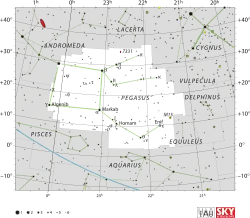| CTA 102 | |
|---|---|
 Pegasus IAU | |
| Observation data (Epoch J2000) | |
| Constellation | Pegasus |
| Right ascension | 22h 32m 36.4s[1] |
| Declination | +11° 43′ 51s″[1] |
| Redshift | 1.037[1] |
| Distance | 8 billion light years[2] |
| Other designations | |
| CTA-102, Q2230+11, QSR B2230+114, QSO J2232+1143, 4C +11.69 | |
| See also: Quasar, List of quasars | |
CTA 102, also known by its B1950 coordinates as 2230+114 (QSR B2230+114) and its J2000 coordinates as J2232+1143 (QSO J2232+1143), is a blazar-type quasar discovered in the early 1960s by a radio survey carried out by the California Institute of Technology.[3] It has been observed by a large range of instruments since its discovery, including WMAP, EGRET, GALEX, VSOP and Parkes,[1] and has been regularly imaged by the Very Long Baseline Array since 1995.[4] It has also been detected in gamma rays, and a gamma-ray flare has been detected from it.[5]
In 1963 Nikolai Kardashev proposed that the then-unidentified radio source could be evidence of a Type II or III extraterrestrial civilization on the Kardashev scale.[3] Follow-up observations were announced in 1965 by Gennady Sholomitskii, who found that the object's radio emission was varying;[6] a public announcement of these results on April 12, 1965, caused a worldwide sensation.[7] The idea that the emission was caused by a civilization was rejected when the radio source was later identified as one of the many varieties of a quasar.[3]
CTA 102 is one of the two great false alarms in the history of the search for extra-terrestrial life, the other being the discovery of pulsars, specifically PSR B1919+21, which are rotating neutron stars.
The American folk rock band The Byrds whimsically reflected the original view that CTA-102 was a sign of extraterrestrial intelligence in their song "C.T.A.-102" from their 1967 album Younger Than Yesterday.[8]
In late 2016 CTA 102, usually glowing around magnitude +17, had a bright outburst in visible light to magnitude +11 (~250 times brighter than usual).[9][10] This likely was the most luminous blazar state ever observed,[11] with an absolute magnitude in excess of -32.
A new outburst began in December 2017, with increased gamma-ray[12] and optical activity.[13] As of 22 December 2017, it has reached magnitude +14.[14]
See also
- PSR B1919+21, the first pulsar discovered, mistaken for an alien radio signal
- HD 164595
References
- 1 2 3 4 "CTA 102 in the NASA Extragalactic Database". Retrieved 2008-12-24.
- ↑ "Galaxy 8 billion light years away offers insight into supermassive black holes". 19 December 2017. Retrieved 5 August 2019.
- 1 2 3 "CTA-102". Internet Encyclopedia of Space; David Darling. Retrieved 2008-12-14.
- ↑ "MOJAVE Sample: 2230+114". Archived from the original on 2016-08-06. Retrieved 2008-12-25.
- ↑ "Fermi LAT detection of a GeV flare from blazar CTA 102". Astronomers Telegram. 3 May 2011. Retrieved 3 May 2011.
- ↑ Sholomitsky, G. B. (1965). "Variability of the Radio Source CTA-102". Information Bulletin on Variable Stars. 83: 1. Bibcode:1965IBVS...83....1S.
- ↑ Rebecca Charbonneau. "This Month in Astronomical History: April 2023".
- ↑ Rogan, Johnny (2011). Byrds: Requiem for the Timeless. Rogan House. pp. 317–320. ISBN 978-0-95295-408-8.
- ↑ "Quasar CTA 102: Historically Bright, Violently Variable". Sky & Telescope. 23 November 2016.
- ↑ "Swift XRT and UVOT flares accompany brightest ever gamma-ray flare of CTA 102". Astronomers Telegram. 1 Jan 2017. Retrieved 23 July 2020.
- ↑ "CTA 102 brightens up to the most luminous optical blazar state ever detected". Astronomers Telegram. 16 Dec 2016. Retrieved 23 July 2020.
- ↑ "AGILE detection of increasing gamma-ray activity from CTA 102". Astronomers Telegram. 9 Dec 2017. Retrieved 23 July 2020.
- ↑ "CRTS-II Detection of Increased Optical Activity from CTA 102". Astronomers Telegram. 9 Dec 2017. Retrieved 23 July 2020.
- ↑ "AAVSO – WebObs Search Results".